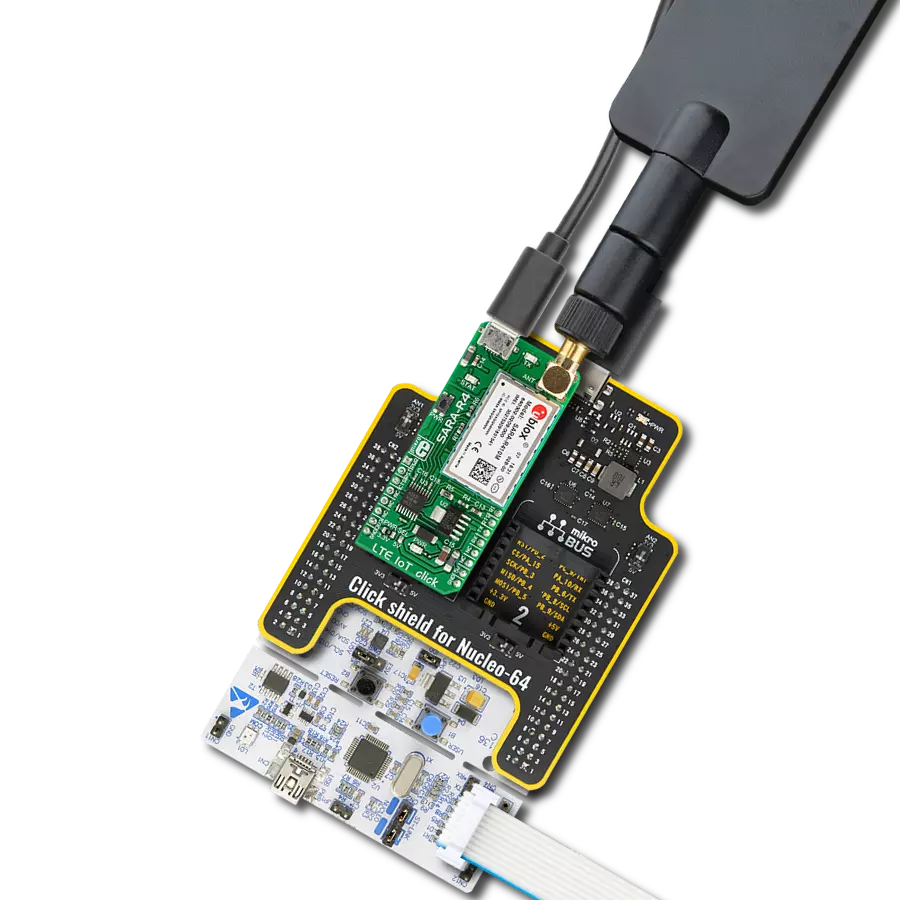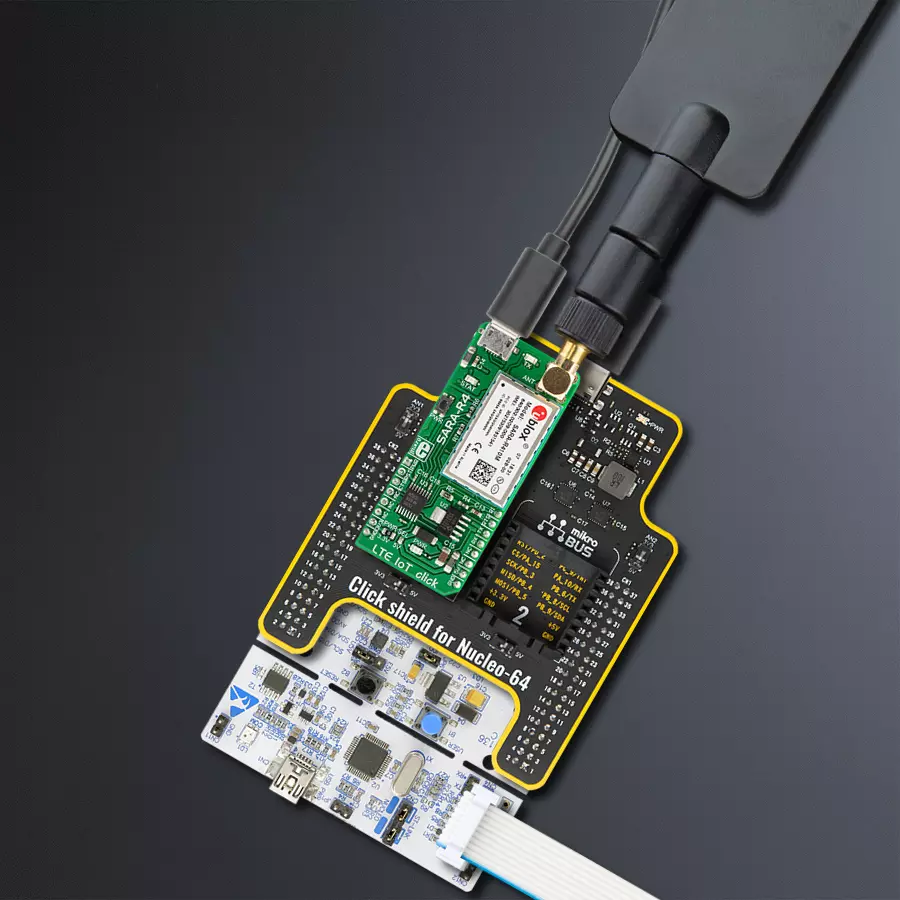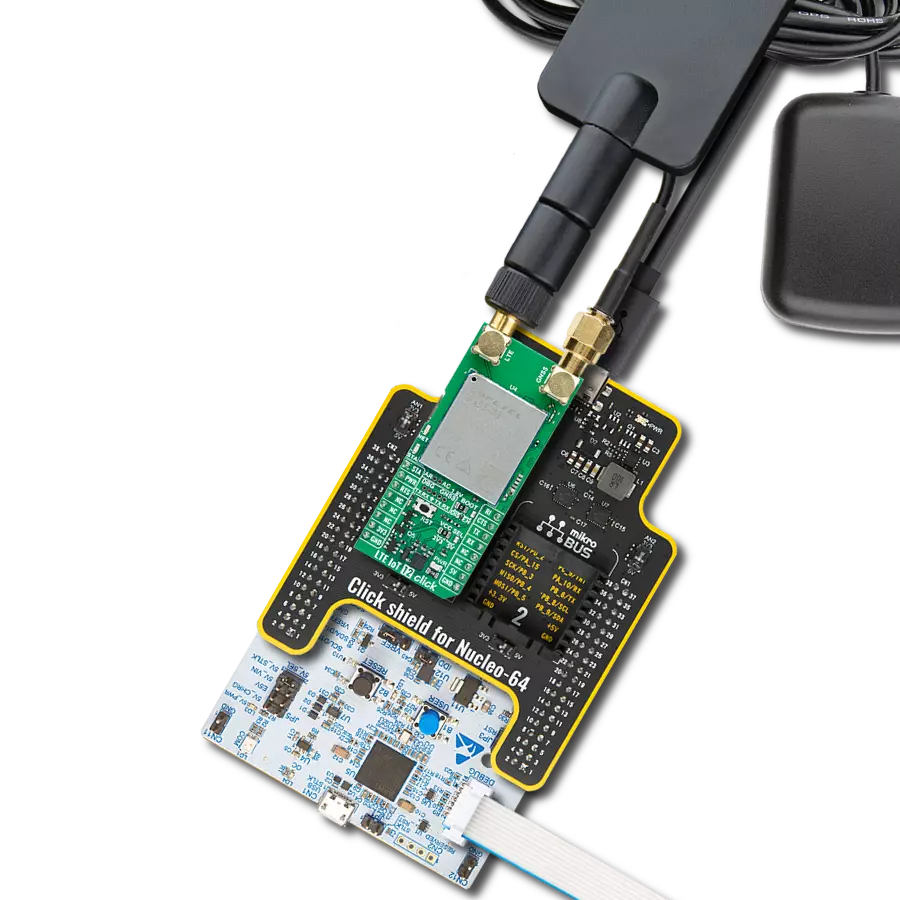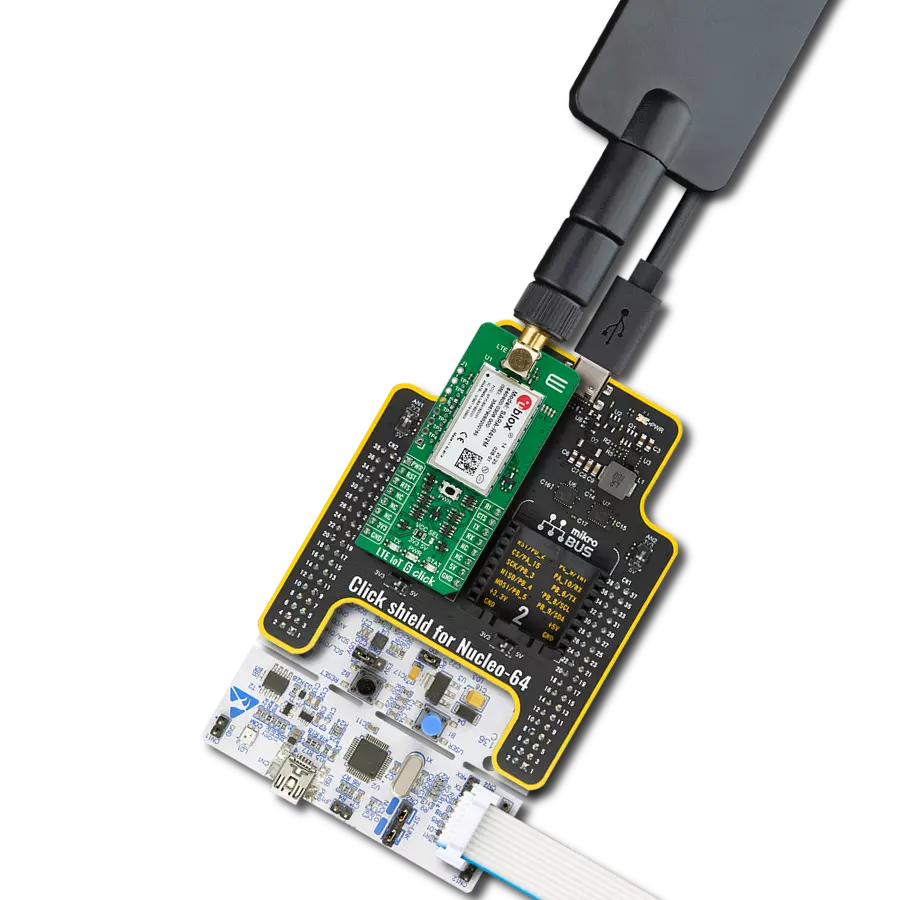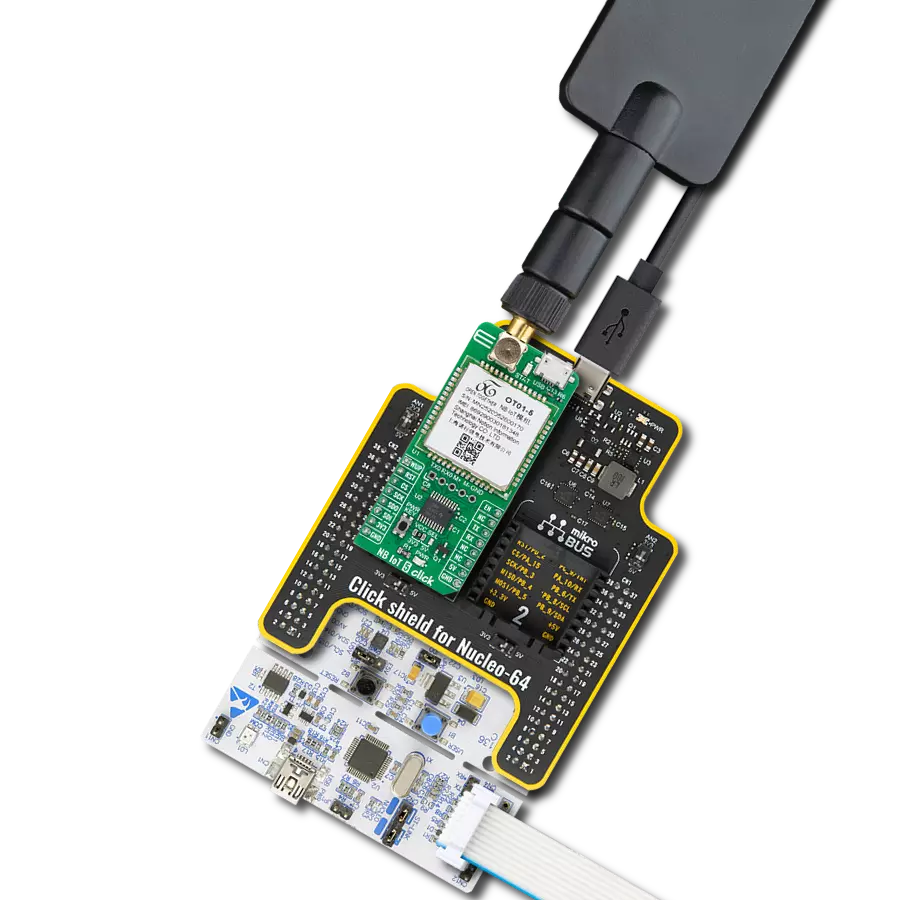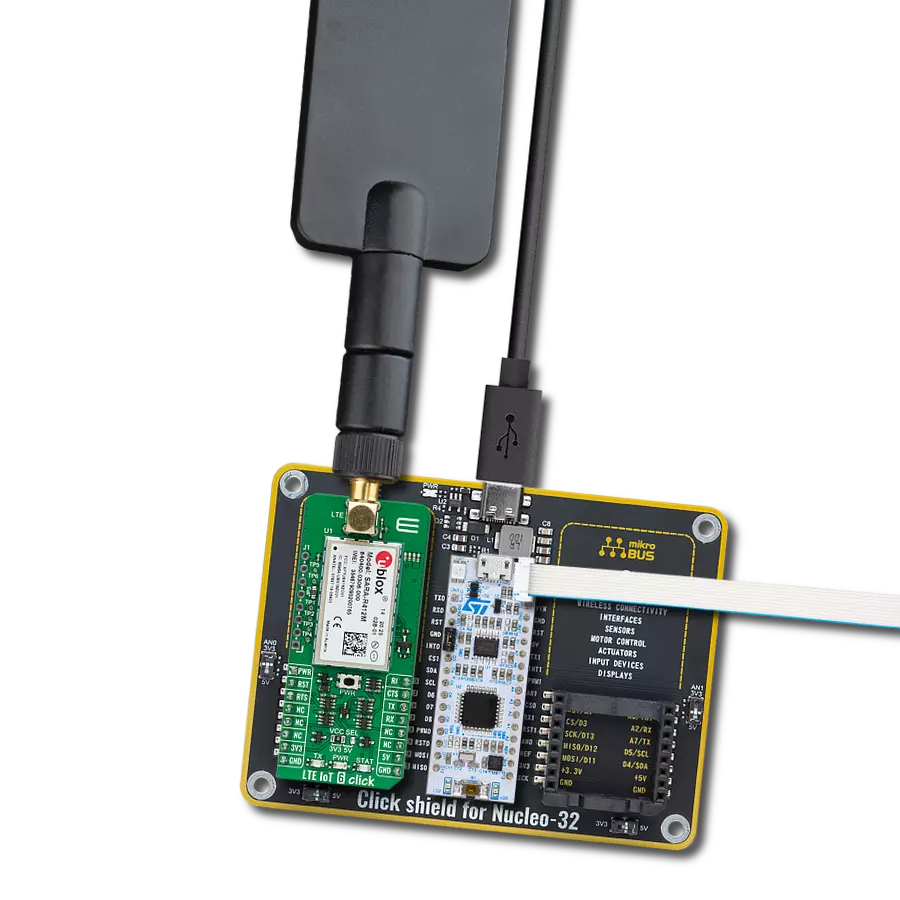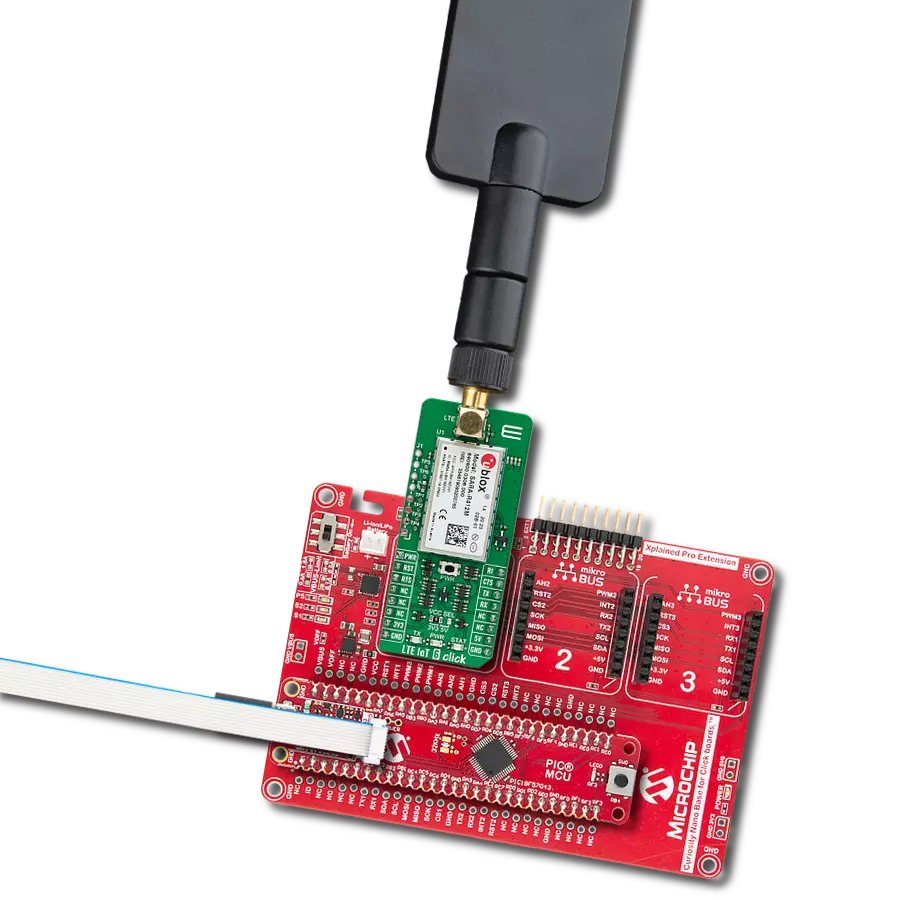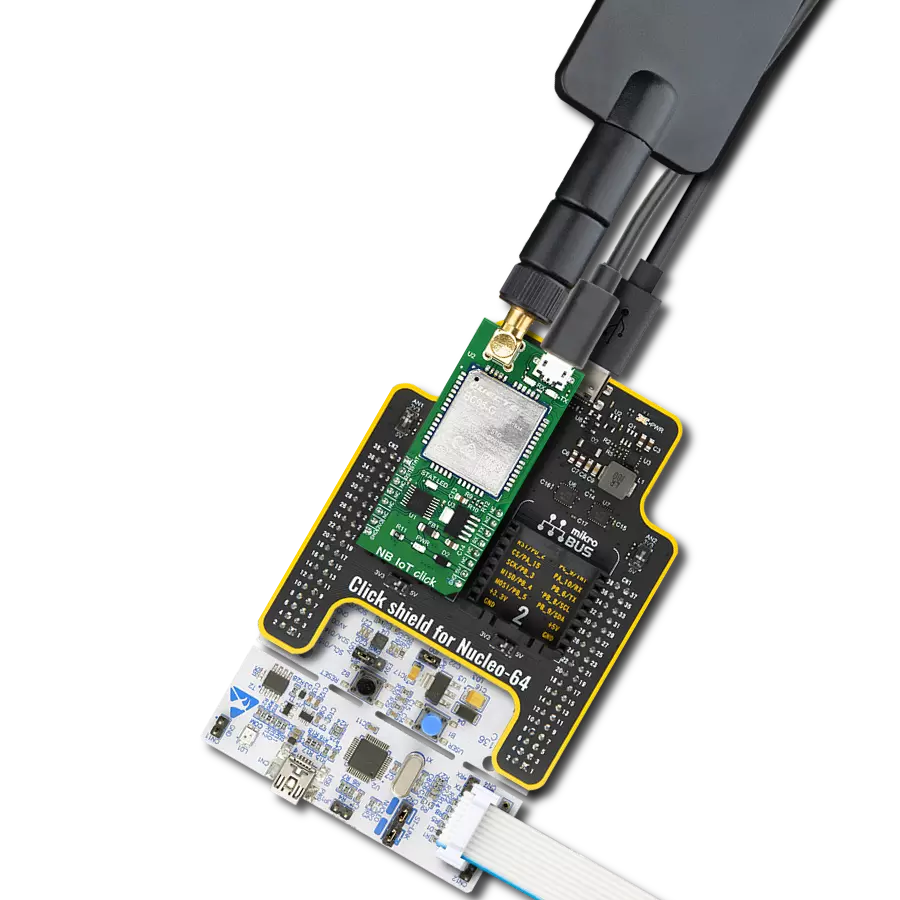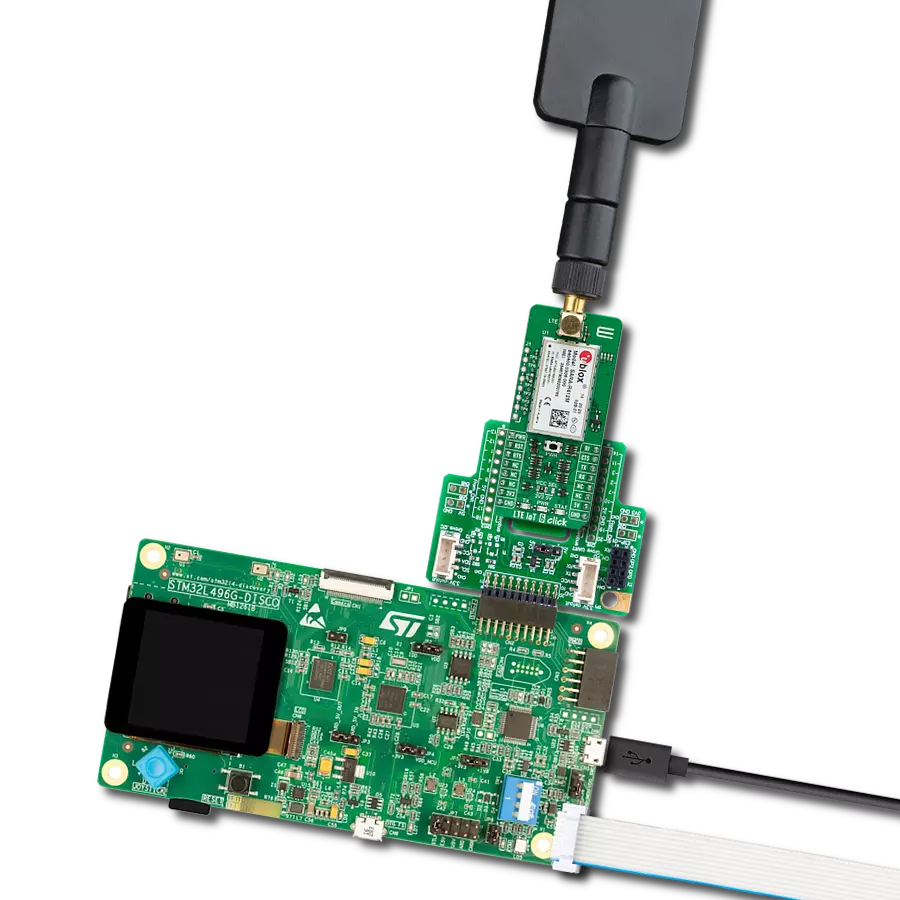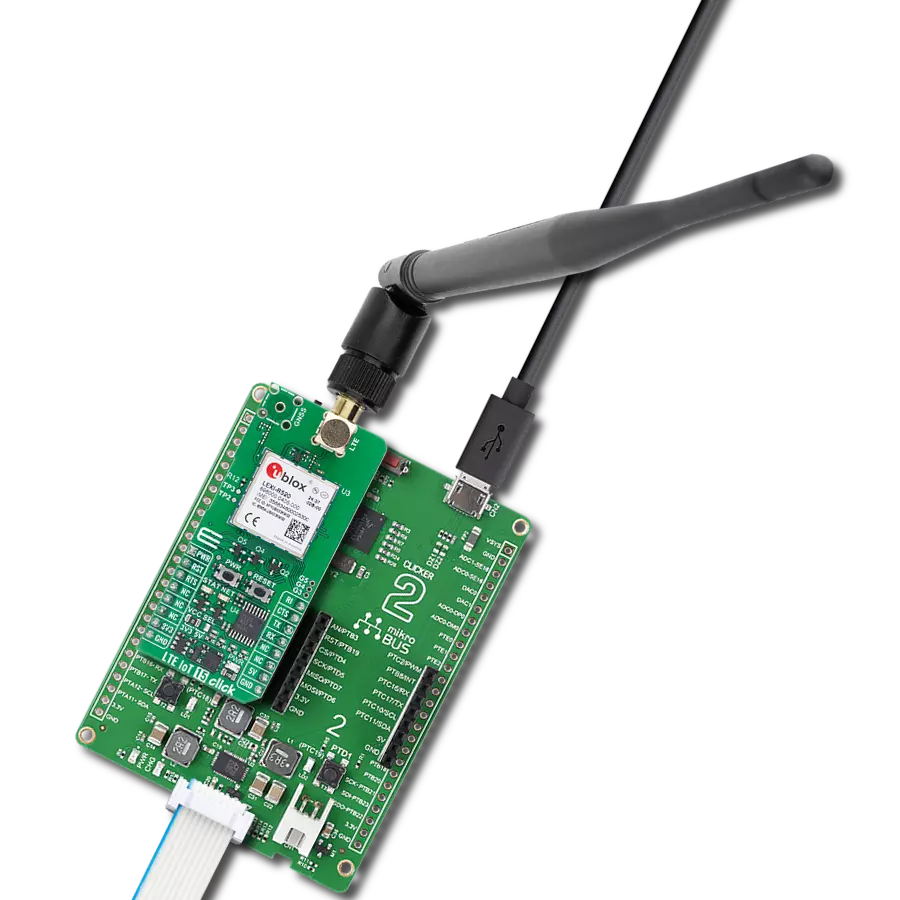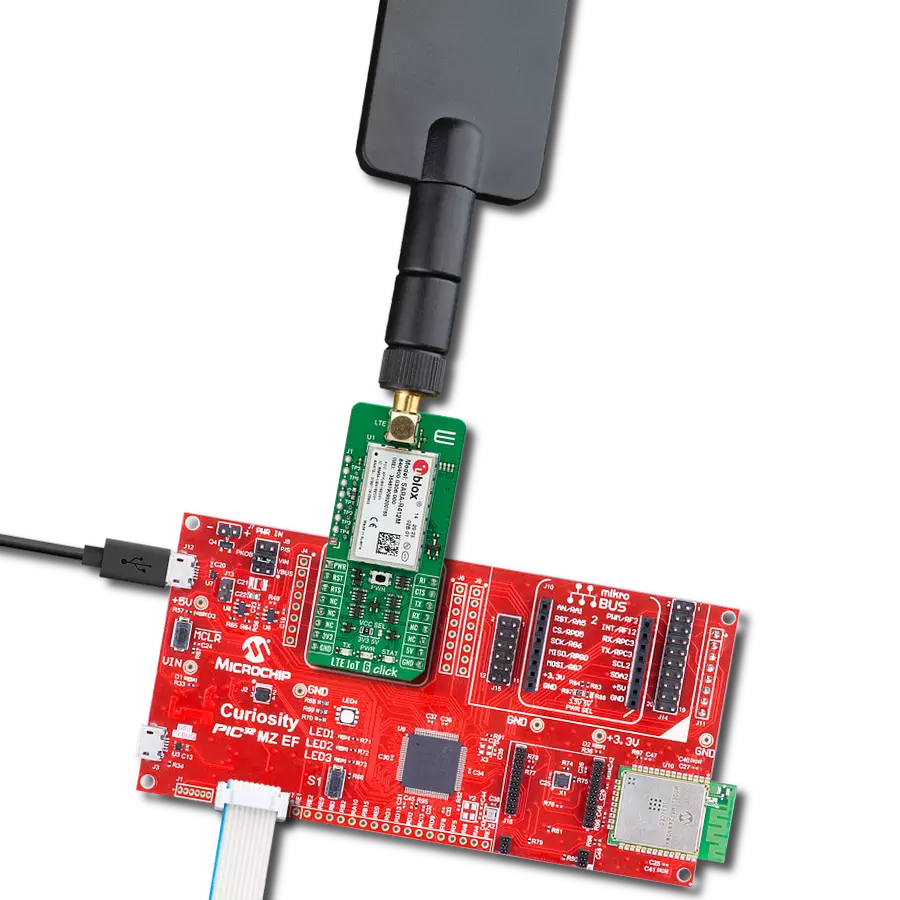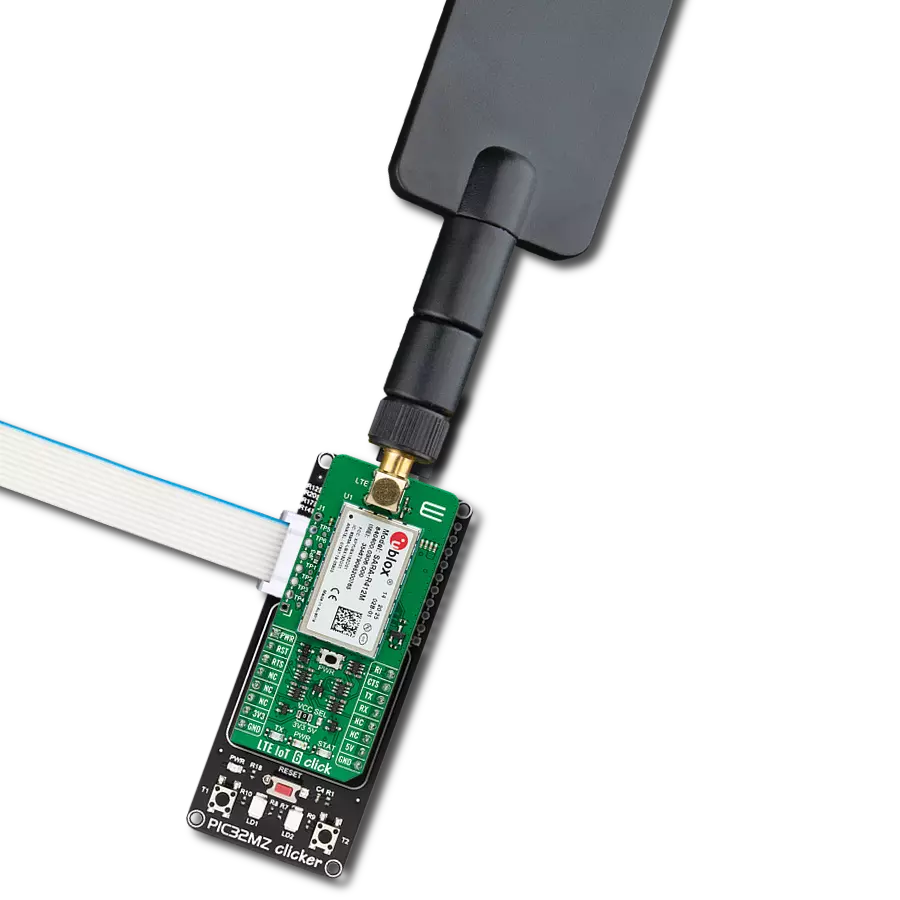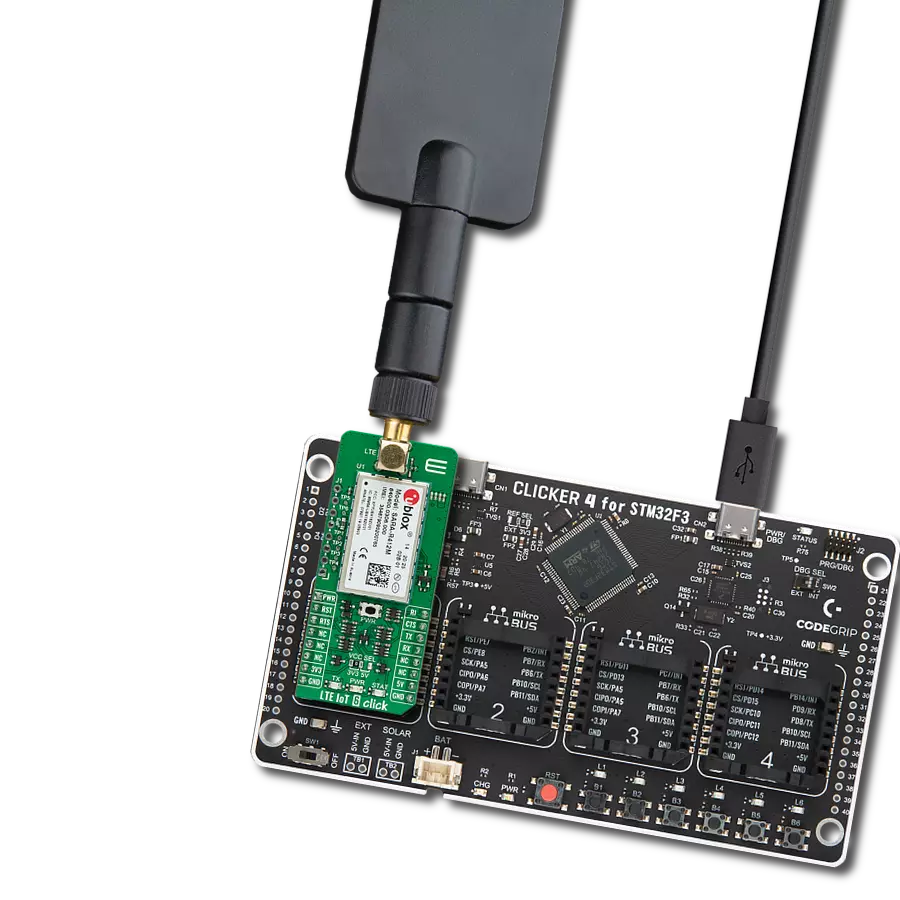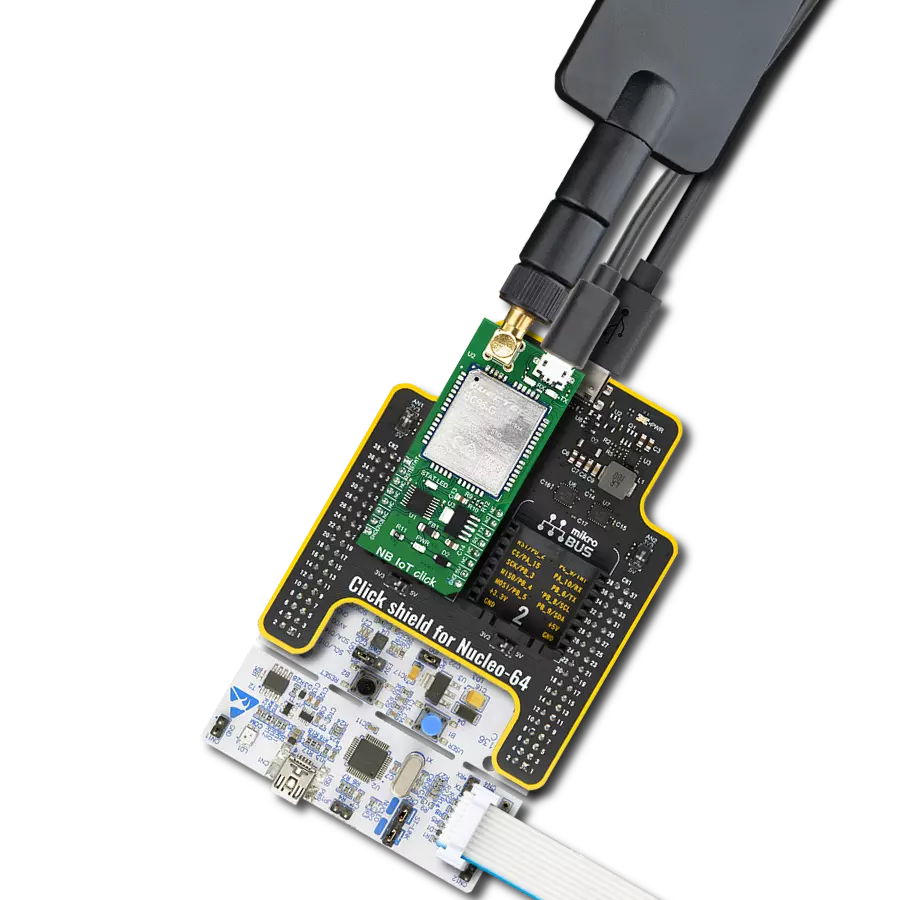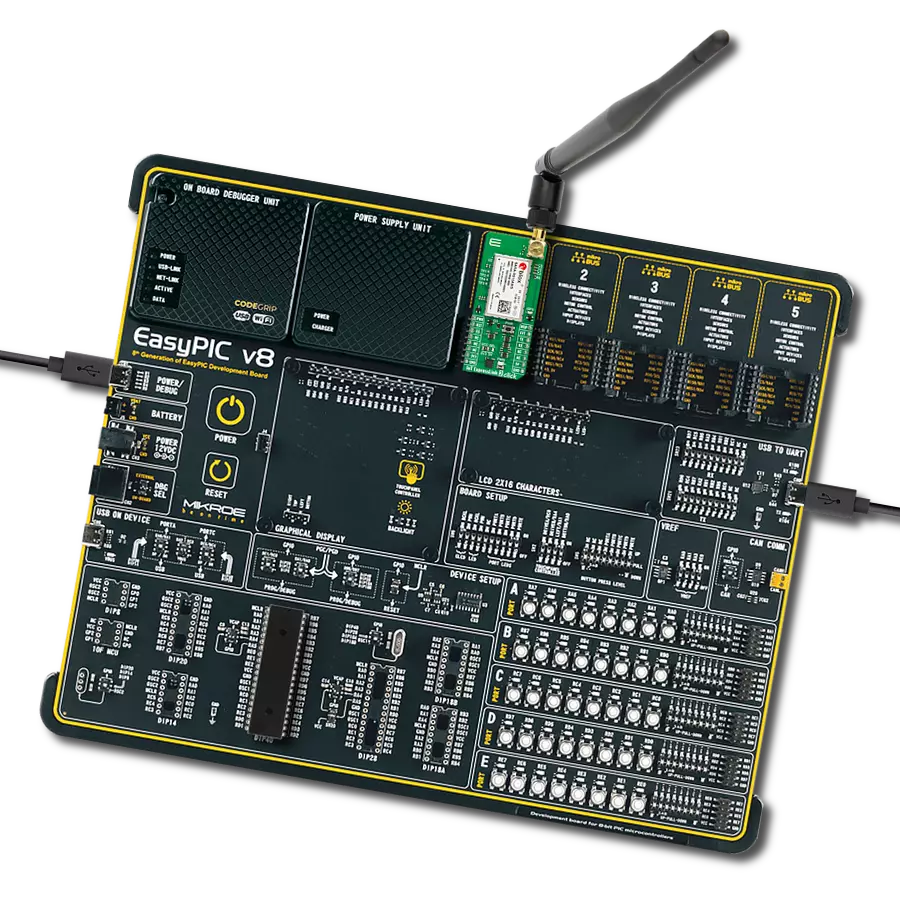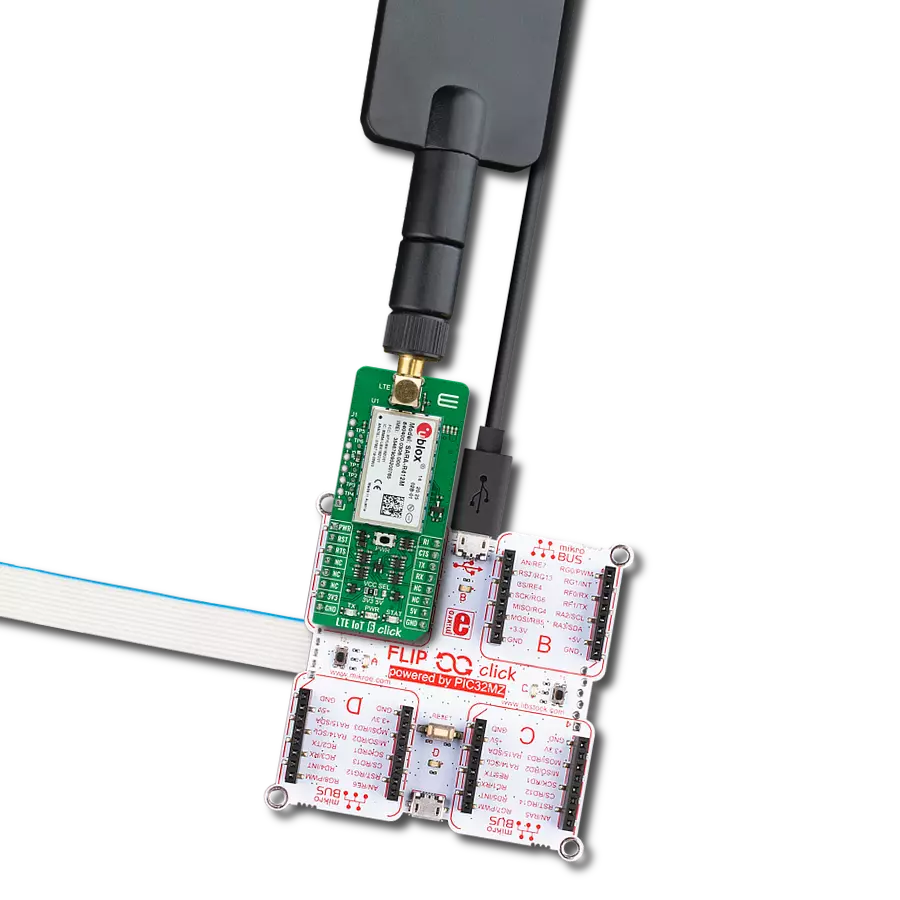通过 LTE IoT 赋能您的物联网项目,无缝集成 CAT M1 和 NB1 技术,开启无限连接的可能性。
A
A
硬件概览
它是如何工作的?
LTE IoT Click 基于 u-Blox 的 SARA-R410M-02B,这是一个可配置的 LTE Cat M1/NB1 多模模块,具有全球物联网和 M2M 应用支持。该模块由多个内部块或部分组成,例如 RF 和内存部分、电源管理部分以及具有外围接口的蜂窝基带处理器。它支持 UART 和 USB 接口,以及外部 SIM 卡/芯片接口,具有超低功耗和成本优化的解决方案,非常适合开发 LPWA 物联网应用。它还提供扩展的不连续接收(e-DRX),将电池寿命延长至 10 年。SARA-R410M-02B 的另一个优点是硬件已准备好在未来支持通过 Cat M1 的 VoLTE 实现语音功能,可用于需要一定人机交互的应用,例如安全应用中的报警面板。SARA-R410M-02B 模块的电源由 Microchip 的 1A 低压差输出(LDO)稳压器 MCP1826 调节至 3.8V。模块的数字接口供电输出引脚为 Texas Instruments 的 6 位双向电平转换和电压转换器 TXB0106 的一侧提供所需的参考电压。模块的主 UART 总线连接到 TXB0106 电平转换器的一侧,而另一侧连接到相应的 mikroBUS™ UART 引脚。电
平转换器另一侧的参考电压取自板载 SMD 跳线,标记为 PWR SEL,用于在 3.3V 和 5V 之间选择 mikroBUS™,取决于所用 MCU 类型及其逻辑电压水平要求。SARA-R410M-02B 模块使用 UART 接口与 MCU 通信,常用的 UART RX 和 TX 引脚,包括硬件流控制引脚 UART CTS、RTS、RI(清除发送、准备发送和响铃指示器)。它支持自动波特率检测,默认配置为 115200 bps,用于数据传输和与主 MCU 交换 AT 通信命令。除了默认波特率外,UART 接口还支持 9600、19200、38400 和 57600 波特率。该接口还可以作为设备连接到 USB 主机,例如个人计算机(PC),允许使用 u-Blox 提供的专有应用程序 m-center,提供干净且全面的接口,用于访问模块的主要功能、设置配置参数、管理 SMS 消息、跟踪模块活动等。LTE IoT Click 具有 50Ω 阻抗的 SMA 天线连接器,可以用于连接 MikroE 提供的合适天线,例如橡胶天线 GSM/GPRS 直角。这款天线非常适合所有 GSM/GPRS 应用,支持一系列频率和频段。Click board™ 背面有一个 Micro
SIM 卡插槽,用于安装 micro SIM 卡,允许连接到蜂窝网络,支持 1.8V 和 3V SIM 卡类型。板载低电平有效的按钮标记为 PWR,连接到 mikroBUS™ 的 AN 引脚,代表点火(开机)按钮,其成功操作将由 STAT LED 指示。如果设备已启动,该引脚上持续 1.5 秒的低脉冲将关闭模块。也可以通过发出 AT+CPWROFF 命令或使用连接到 mikroBUS™ RST 引脚的复位功能关闭模块,这将通过在该引脚上发送持续 10 秒的有效低输入导致突然断电(强制断电)。此 Click board™ 具有两个 LED 指示灯:黄色 LED 标记为 STAT,用于直观指示设备的操作状态,红色 LED 标记为 TX,用于指示网络状态。此 Click Board™ 设计用于使用 3.3V 和 5V 逻辑电压水平,可通过 PWR SEL 跳线选择。适当的电压电平转换器执行正确的逻辑电压电平转换,而 LDO 确保模块由推荐值供电。这样,3.3V 和 5V 兼容的 MCU 都可以正确使用通信线路。此外,此 Click board™ 配备了一个库,包含易于使用的函数和示例代码,可用于进一步开发。
功能概述
开发板
Nucleo-64搭载STM32L073RZ MCU提供了一个经济实惠且灵活的平台,供开发人员探索新的想法并原型化其设计。该板利用了STM32微控制器的多功能性,使用户能够为其项目选择性能和功耗之间的最佳平衡。它采用LQFP64封装的STM32微控制器,并包括一些必要的组件,例如用户LED,可以同时作为ARDUINO®信号使用,以及用户和复位按钮,以及用于精准定时操作的32.768kHz晶体振荡器。设计时考虑了扩展性和灵活性,Nucleo-64板具有ARDUINO®
Uno V3扩展连接器和ST morpho扩展引脚标头,为全面项目集成提供了对STM32 I/O的完全访问权限。电源选项具有适应性,支持ST-LINK USB VBUS或外部电源,确保在各种开发环境中的适应性。该板还配备了一个内置的ST-LINK调试器/编程器,具有USB重新枚举功能,简化了编程和调试过程。此外,该板还设计了外部SMPS,以实现有效的Vcore逻辑供电,支持USB设备全速或USB SNK/UFP全速,以及内置的加密功能,增强了项目的功耗效率和安全性。通过专用
连接器提供了额外的连接性,用于外部SMPS实验、ST-LINK的USB连接器和MIPI®调试连接器,扩展了硬件接口和实验的可能性。开发人员将通过STM32Cube MCU软件包中全面的免费软件库和示例得到广泛的支持。这与与各种集成开发环境(IDE)的兼容性相结合,包括IAR Embedded Workbench®、MDK-ARM和STM32CubeIDE,确保了平稳高效的开发体验,使用户能够充分发挥Nucleo-64板在其项目中的功能。
微控制器概述
MCU卡片 / MCU
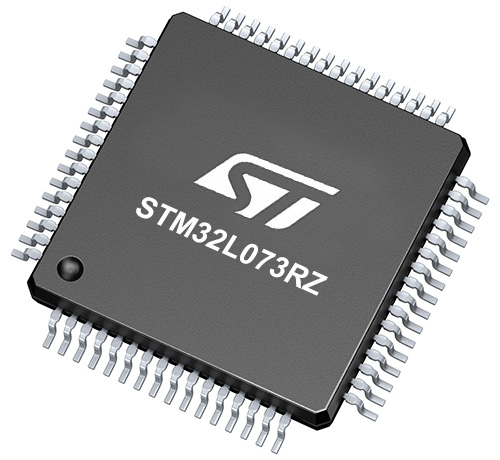
建筑
ARM Cortex-M0
MCU 内存 (KB)
192
硅供应商
STMicroelectronics
引脚数
64
RAM (字节)
20480
你完善了我!
配件
Click Shield for Nucleo-64 配备了两个专有的 mikroBUS™ 插座,使得所有的 Click board™ 设备都可以轻松地与 STM32 Nucleo-64 开发板连接。这样,Mikroe 允许其用户从不断增长的 Click boards™ 范围中添加任何功能,如 WiFi、GSM、GPS、蓝牙、ZigBee、环境传感器、LED、语音识别、电机控制、运动传感器等。您可以使用超过 1537 个 Click boards™,这些 Click boards™ 可以堆叠和集成。STM32 Nucleo-64 开发板基于 64 引脚封装的微控制器,采用 32 位 MCU,配备 ARM Cortex M4 处理器,运行速度为 84MHz,具有 512Kb Flash 和 96KB SRAM,分为两个区域,顶部区域代表 ST-Link/V2 调试器和编程器,而底部区域是一个实际的开发板。通过 USB 连接方便地控制和供电这些板子,以便直接对 Nucleo-64 开发板进行编程和高效调试,其中还需要额外的 USB 线连接到板子上的 USB 迷你接口。大多数 STM32 微控制器引脚都连接到了板子左右边缘的 IO 引脚上,然后连接到两个现有的 mikroBUS™ 插座上。该 Click Shield 还有几个开关,用于选择 mikroBUS™ 插座上模拟信号的逻辑电平和 mikroBUS™ 插座本身的逻辑电压电平。此外,用户还可以通过现有的双向电平转换器,使用任何 Click board™,无论 Click board™ 是否在 3.3V 或 5V 逻辑电压电平下运行。一旦将 STM32 Nucleo-64 开发板与我们的 Click Shield for Nucleo-64 连接,您就可以访问数百个工作于 3.3V 或 5V 逻辑电压电平的 Click boards™。
LTE 平面旋转天线是一种多功能选择,可提升 3G/4G LTE 设备的性能。其宽频率范围为 700-2700MHz,确保在全球主要蜂窝频段上的最佳连接。此平板天线配有 SMA 公连接器,可轻松直接连接到您的设备或 SMA 模块连接器。其一大亮点是可调节角度,可按 45⁰ 的增量(0⁰/45⁰/90⁰)设置,使您能够微调天线方向以实现最大信号接收。具有 50Ω 的阻抗和 <2.0:1 的电压驻波比(VSWR),这款天线可确保可靠高效的连接。其 5dB 的增益、垂直极化和全向辐射模式增强了信号强度,适用于各种应用。天线尺寸为 196mm 长和 38mm 宽,提供紧凑而有效的解决方案以改善连接。其最大输入功率为 50W,能够满足各种设备的需求。
使用的MCU引脚
mikroBUS™映射器
“仔细看看!”
Click board™ 原理图

一步一步来
项目组装
实时跟踪您的结果
应用程序输出
1. 应用程序输出 - 在调试模式下,“应用程序输出”窗口支持实时数据监控,直接提供执行结果的可视化。请按照提供的教程正确配置环境,以确保数据正确显示。

2. UART 终端 - 使用UART Terminal通过USB to UART converter监视数据传输,实现Click board™与开发系统之间的直接通信。请根据项目需求配置波特率和其他串行设置,以确保正常运行。有关分步设置说明,请参考提供的教程。

3. Plot 输出 - Plot功能提供了一种强大的方式来可视化实时传感器数据,使趋势分析、调试和多个数据点的对比变得更加直观。要正确设置,请按照提供的教程,其中包含使用Plot功能显示Click board™读数的分步示例。在代码中使用Plot功能时,请使用以下函数:plot(insert_graph_name, variable_name);。这是一个通用格式,用户需要将“insert_graph_name”替换为实际图表名称,并将“variable_name”替换为要显示的参数。

软件支持
库描述
此库包含 LTE IoT Click 驱动程序的 API。
关键功能:
lteiot_power_on- LTE IoT 模块电源开启lteiot_send_cmd- 发送命令功能
开源
代码示例
完整的应用程序代码和一个现成的项目可以通过NECTO Studio包管理器直接安装到NECTO Studio。 应用程序代码也可以在MIKROE的GitHub账户中找到。
/*!
* \file
* \brief LteIot Click example
*
* # Description
* This example reads and processes data from LTE IoT Click.
*
* The demo application is composed of two sections :
*
* ## Application Init
* Initializes driver and wake-up module and sets default configuration for connecting device to network.
*
* ## Application Task
* Waits for device to connect to network and then sends SMS to selected phone number.
*
* ## Additional Function
* - static void lteiot_clear_app_buf ( void )
* - static void lteiot_error_check( err_t error_flag )
* - static void lteiot_log_app_buf ( void )
* - static void lteiot_check_connection( void )
* - static err_t lteiot_rsp_check ( void )
* - static err_t lteiot_process ( void )
*
* @note
* In order for the example to work,
* user needs to set the phone number and sim apn to which he wants to send an SMS
* Enter valid data for the following macros: SIM_APN and PHONE_NUMBER_TO_MESSAGE.
* E.g.
SIM_APN "vipmobile"
PHONE_NUMBER_TO_MESSAGE "999999999"
*
* @author MikroE Team
*
*/
// ------------------------------------------------------------------- INCLUDES
#include "board.h"
#include "log.h"
#include "lteiot.h"
#define APP_OK 0
#define APP_ERROR_DRIVER -1
#define APP_ERROR_OVERFLOW -2
#define APP_ERROR_TIMEOUT -3
#define RSP_OK "OK"
#define RSP_ERROR "ERROR"
#define SIM_APN "" // Set valid SIM APN
#define PHONE_NUMBER_TO_MESSAGE "" // Set Phone number to message
#define MESSAGE_CONTENT "LTE IoT Click" // Messege content
#define PROCESS_BUFFER_SIZE 500
#define WAIT_FOR_CONNECTION 0
#define CONNECTED_TO_NETWORK 1
static lteiot_t lteiot;
static log_t logger;
static char app_buf[ PROCESS_BUFFER_SIZE ] = { 0 };
static int32_t app_buf_len = 0;
static int32_t app_buf_cnt = 0;
static uint8_t app_connection_status = WAIT_FOR_CONNECTION;
static err_t app_error_flag;
/**
* @brief LTE IoT clearing application buffer.
* @details This function clears memory of application buffer and reset its length and counter.
* @note None.
*/
static void lteiot_clear_app_buf ( void );
/**
* @brief LTE IoT data reading function.
* @details This function reads data from device and concats data to application buffer.
*
* @return @li @c 0 - Read some data.
* @li @c -1 - Nothing is read.
* @li @c -2 - Application buffer overflow.
*
* See #err_t definition for detailed explanation.
* @note None.
*/
static err_t lteiot_process ( void );
/**
* @brief LTE IoT check for errors.
* @details This function checks for different types of errors and logs them on UART.
* @note None.
*/
static void lteiot_error_check( err_t error_flag );
/**
* @brief LTE IoT logs application buffer.
* @details This function logs data from application buffer.
* @note None.
*/
static void lteiot_log_app_buf ( void );
/**
* @brief LTE IoT response check.
* @details This function checks for response and returns the status of response.
*
* @return application status.
* See #err_t definition for detailed explanation.
* @note None.
*/
static err_t lteiot_rsp_check ( void );
/**
* @brief LTE IoT chek connection.
* @details This function checks connection to the network and
* logs that status to UART.
*
* @note None.
*/
static void lteiot_check_connection( void );
// ------------------------------------------------------ APPLICATION FUNCTIONS
void application_init ( void )
{
log_cfg_t log_cfg; /**< Logger config object. */
lteiot_cfg_t lteiot_cfg; /**< Click config object. */
/**
* Logger initialization.
* Default baud rate: 115200
* Default log level: LOG_LEVEL_DEBUG
* @note If USB_UART_RX and USB_UART_TX
* are defined as HAL_PIN_NC, you will
* need to define them manually for log to work.
* See @b LOG_MAP_USB_UART macro definition for detailed explanation.
*/
LOG_MAP_USB_UART( log_cfg );
log_init( &logger, &log_cfg );
log_info( &logger, " Application Init " );
Delay_ms ( 1000 );
// Click initialization.
lteiot_cfg_setup( <eiot_cfg );
LTEIOT_MAP_MIKROBUS( lteiot_cfg, MIKROBUS_1 );
err_t init_flag = lteiot_init( <eiot, <eiot_cfg );
if ( init_flag == UART_ERROR )
{
log_error( &logger, " Application Init Error. " );
log_info( &logger, " Please, run program again... " );
for ( ; ; );
}
log_info( &logger, " Power on device... " );
lteiot_power_on( <eiot );
// dummy read
lteiot_process( );
lteiot_clear_app_buf( );
// AT
lteiot_send_cmd( <eiot, LTEIOT_CMD_AT );
app_error_flag = lteiot_rsp_check( );
lteiot_error_check( app_error_flag );
Delay_ms ( 500 );
// ATI - product information
lteiot_send_cmd( <eiot, LTEIOT_CMD_ATI );
app_error_flag = lteiot_rsp_check( );
lteiot_error_check( app_error_flag );
Delay_ms ( 500 );
// CGMR - firmware version
lteiot_send_cmd( <eiot, LTEIOT_CMD_CGMR );
app_error_flag = lteiot_rsp_check( );
lteiot_error_check( app_error_flag );
Delay_ms ( 500 );
// COPS - deregister from network
lteiot_send_cmd_with_parameter( <eiot, LTEIOT_CMD_COPS, "2" );
app_error_flag = lteiot_rsp_check( );
lteiot_error_check( app_error_flag );
Delay_ms ( 500 );
// CGDCONT - set sim apn
lteiot_set_sim_apn( <eiot, SIM_APN );
app_error_flag = lteiot_rsp_check( );
lteiot_error_check( app_error_flag );
Delay_ms ( 500 );
// CFUN - full funtionality
lteiot_send_cmd_with_parameter( <eiot, LTEIOT_CMD_CFUN, "1" );
app_error_flag = lteiot_rsp_check( );
lteiot_error_check( app_error_flag );
Delay_ms ( 500 );
// COPS - automatic mode
lteiot_send_cmd_with_parameter( <eiot, LTEIOT_CMD_COPS, "0" );
app_error_flag = lteiot_rsp_check( );
lteiot_error_check( app_error_flag );
Delay_ms ( 1000 );
Delay_ms ( 1000 );
// CEREG - network registration status
lteiot_send_cmd_with_parameter( <eiot, LTEIOT_CMD_CEREG, "2" );
app_error_flag = lteiot_rsp_check( );
lteiot_error_check( app_error_flag );
Delay_ms ( 500 );
// CIMI - request IMSI
lteiot_send_cmd( <eiot, LTEIOT_CMD_CIMI );
app_error_flag = lteiot_rsp_check( );
lteiot_error_check( app_error_flag );
Delay_ms ( 500 );
app_buf_len = 0;
app_buf_cnt = 0;
app_connection_status = WAIT_FOR_CONNECTION;
log_info( &logger, " Application Task " );
Delay_ms ( 1000 );
Delay_ms ( 1000 );
Delay_ms ( 1000 );
Delay_ms ( 1000 );
Delay_ms ( 1000 );
}
void application_task ( void )
{
if ( app_connection_status == WAIT_FOR_CONNECTION )
{
// CGATT - request IMSI
lteiot_send_cmd_check( <eiot, LTEIOT_CMD_CGATT );
app_error_flag = lteiot_rsp_check( );
lteiot_error_check( app_error_flag );
Delay_ms ( 500 );
// CEREG - network registration status
lteiot_send_cmd_check( <eiot, LTEIOT_CMD_CEREG );
app_error_flag = lteiot_rsp_check( );
lteiot_error_check( app_error_flag );
Delay_ms ( 500 );
// CSQ - signal quality
lteiot_send_cmd( <eiot, LTEIOT_CMD_CSQ );
app_error_flag = lteiot_rsp_check( );
lteiot_error_check( app_error_flag );
Delay_ms ( 1000 );
Delay_ms ( 1000 );
Delay_ms ( 1000 );
Delay_ms ( 1000 );
Delay_ms ( 1000 );
}
else
{
log_info( &logger, "CONNECTED TO NETWORK" );
// SMS message format - text mode
lteiot_send_cmd_with_parameter( <eiot, "AT+CMGF", "1" );
app_error_flag = lteiot_rsp_check( );
lteiot_error_check( app_error_flag );
Delay_ms ( 1000 );
Delay_ms ( 1000 );
Delay_ms ( 1000 );
for( ; ; )
{
log_printf( &logger, "> Sending message to phone number...\r\n" );
lteiot_send_text_message( <eiot, PHONE_NUMBER_TO_MESSAGE, MESSAGE_CONTENT );
app_error_flag = lteiot_rsp_check( );
lteiot_error_check( app_error_flag );
// 30 seconds delay
Delay_ms ( 1000 );
Delay_ms ( 1000 );
Delay_ms ( 1000 );
Delay_ms ( 1000 );
Delay_ms ( 1000 );
Delay_ms ( 1000 );
Delay_ms ( 1000 );
Delay_ms ( 1000 );
Delay_ms ( 1000 );
Delay_ms ( 1000 );
Delay_ms ( 1000 );
Delay_ms ( 1000 );
Delay_ms ( 1000 );
Delay_ms ( 1000 );
Delay_ms ( 1000 );
Delay_ms ( 1000 );
Delay_ms ( 1000 );
Delay_ms ( 1000 );
Delay_ms ( 1000 );
Delay_ms ( 1000 );
Delay_ms ( 1000 );
Delay_ms ( 1000 );
Delay_ms ( 1000 );
Delay_ms ( 1000 );
Delay_ms ( 1000 );
Delay_ms ( 1000 );
Delay_ms ( 1000 );
Delay_ms ( 1000 );
Delay_ms ( 1000 );
Delay_ms ( 1000 );
}
}
}
int main ( void )
{
/* Do not remove this line or clock might not be set correctly. */
#ifdef PREINIT_SUPPORTED
preinit();
#endif
application_init( );
for ( ; ; )
{
application_task( );
}
return 0;
}
static void lteiot_clear_app_buf ( void )
{
memset( app_buf, 0, app_buf_len );
app_buf_len = 0;
app_buf_cnt = 0;
}
static err_t lteiot_process ( void )
{
err_t return_flag = APP_ERROR_DRIVER;
int32_t rx_size;
char rx_buff[ PROCESS_BUFFER_SIZE ] = { 0 };
rx_size = lteiot_generic_read( <eiot, rx_buff, PROCESS_BUFFER_SIZE );
if ( rx_size > 0 )
{
int32_t buf_cnt = 0;
return_flag = APP_OK;
if ( app_buf_len + rx_size >= PROCESS_BUFFER_SIZE )
{
lteiot_clear_app_buf( );
return_flag = APP_ERROR_OVERFLOW;
}
else
{
buf_cnt = app_buf_len;
app_buf_len += rx_size;
}
for ( int32_t rx_cnt = 0; rx_cnt < rx_size; rx_cnt++ )
{
if ( rx_buff[ rx_cnt ] != 0 )
{
app_buf[ ( buf_cnt + rx_cnt ) ] = rx_buff[ rx_cnt ];
}
else
{
app_buf_len--;
buf_cnt--;
}
}
}
return return_flag;
}
static err_t lteiot_rsp_check ( void )
{
uint16_t timeout_cnt = 0;
uint16_t timeout = 10000;
err_t error_flag = lteiot_process( );
if ( ( error_flag != 0 ) && ( error_flag != -1 ) )
{
return error_flag;
}
while ( ( strstr( app_buf, RSP_OK ) == 0 ) && ( strstr( app_buf, RSP_ERROR ) == 0 ) )
{
error_flag = lteiot_process( );
if ( ( error_flag != 0 ) && ( error_flag != -1 ) )
{
return error_flag;
}
timeout_cnt++;
if ( timeout_cnt > timeout )
{
while ( ( strstr( app_buf, RSP_OK ) == 0 ) && ( strstr( app_buf, RSP_ERROR ) == 0 ) )
{
lteiot_send_cmd( <eiot, LTEIOT_CMD_AT );
lteiot_process( );
Delay_ms ( 100 );
}
lteiot_clear_app_buf( );
return APP_ERROR_TIMEOUT;
}
Delay_ms ( 1 );
}
lteiot_check_connection();
lteiot_log_app_buf();
log_printf( &logger, "-----------------------------------\r\n" );
return APP_OK;
}
static void lteiot_error_check( err_t error_flag )
{
if ( ( error_flag != 0 ) && ( error_flag != -1 ) )
{
switch ( error_flag )
{
case -2:
log_error( &logger, " Overflow!" );
break;
case -3:
log_error( &logger, " Timeout!" );
break;
default:
break;
}
}
}
static void lteiot_log_app_buf ( void )
{
for ( int32_t buf_cnt = 0; buf_cnt < app_buf_len; buf_cnt++ )
{
log_printf( &logger, "%c", app_buf[ buf_cnt ] );
}
log_printf( &logger, "\r\n" );
lteiot_clear_app_buf( );
}
static void lteiot_check_connection( void )
{
#define CONNECTED "+CGATT: 1"
if ( strstr( app_buf, CONNECTED ) != 0 )
{
app_connection_status = CONNECTED_TO_NETWORK;
}
}
// ------------------------------------------------------------------------ END
额外支持
资源
类别:LTE 物联网
